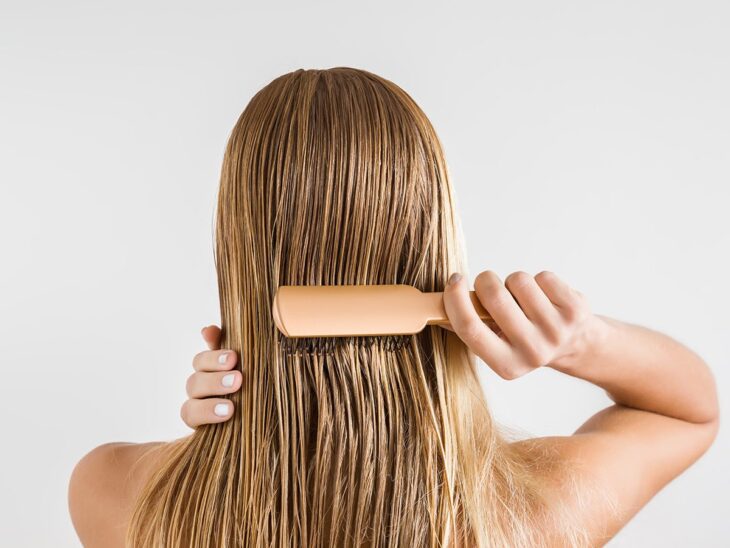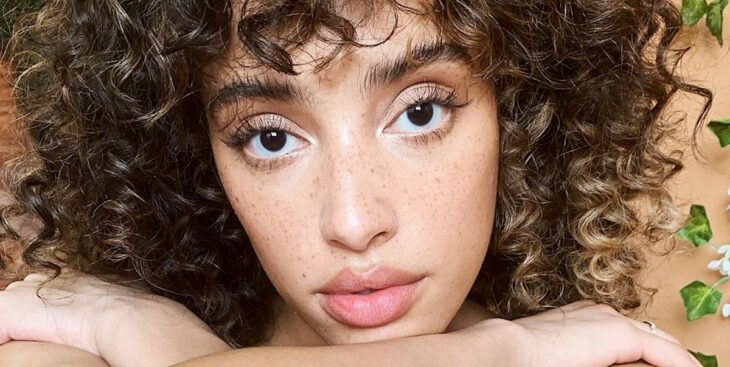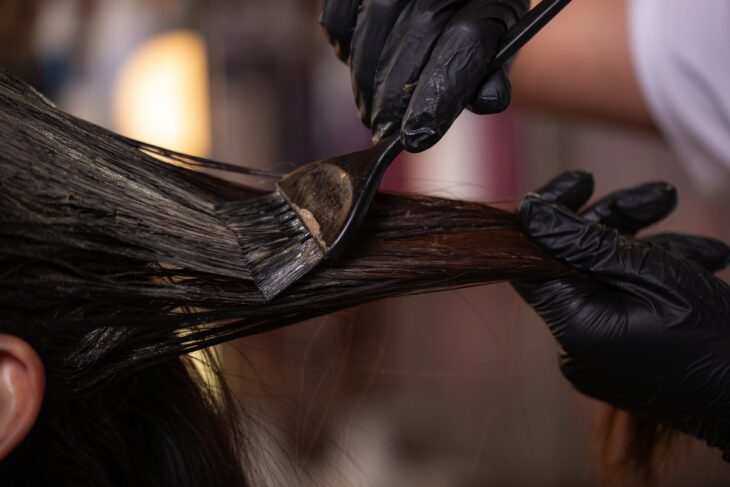Hair fall is one of the most common complaints during pregnancy. Women often experience an amazing amount of hair growth, which they later observe as excessive hair fall after childbirth.
The thickening and enhancement in the volume are attributed to increased estrogen levels during pregnancy (hair follicles are sensitive to hormonal changes), but the excess shedding post-delivery is believed to be caused by falling hormone levels, particularly progesterone. Another factor could be low iron or protein intake, especially if you’re exclusively breastfeeding your baby. Iron deficiency leads to thinning of the blood and poor oxygen-carrying capacity, both of which can contribute to more strands being lost than normal.
It’s important for expectant mothers not to worry about their sudden loss of locks because this is evidently a healthy sign that the body is adjusting to the drastically changed hormonal levels after childbirth. However, if you experience hair fall in excess or notice patches of hair loss, it may indicate an underlying problem like hypothyroidism (in which case you should consult your doctor).
Contents
- 1. Go Short
- 2. Indulge In A Healthy Diet
- 3. Nutritional Supplements
- 4. Have Plenty Of Rest
- 5. Exercise Is A Must
- 6. Follow Healthy Hair Care
- 7. Use The Right Products
- 8. Run Your Fingers Through It
- 9. Avoid Stress Of Any Kind
- 10. Massage your scalp
- 11. Use henna to improve hair growth
- 12. Consult A Professional
1. Go Short

Source: marieclaire.co.uk
One way for expectant mothers to deal with their post-baby hair loss is by getting regular trims (especially because many find themselves sporting a shorter ‘do anyway during pregnancy). This will not only help balance out any unruly ends but can also prevent split ends and breakage—the leading causes of excessive shedding. If possible, ask your stylist for blunt cuts that won’t cause too much thinning throughout your locks.
2. Indulge In A Healthy Diet
Another way to improve the health of your tresses post-pregnancy is to focus on your diet. Make sure you’re getting plenty of protein and iron in particular, which can be found in lean meats, beans and legumes, and green leafy veggies. You can increase blood circulation to your scalp by consuming healthy fats like olive oil, ground flax seeds, fish that are rich in omega 3 fatty acids, and foods that are rich in proteins. Healthy proteins include tuna, chicken, eggs, etc. Drinking enough water is also necessary for hair growth as it will provide the body with all the required nutrients needed for the nourishment of hair. Supplements may also help alleviate any deficiencies that could be causing hair loss.
3. Nutritional Supplements

Source: nia.nih.gov
Supplements can really help. Try adding a prenatal supplement to your diet if you are expecting or planning to become pregnant. You can also look for one that includes biotin, which is found naturally in many foods, including peanuts, soybeans, and walnuts.
4. Have Plenty Of Rest
Getting enough rest may be the most important thing new moms can do for their hair during the first few months of motherhood. Once the baby arrives, it’s not uncommon to feel stressed or suffer from sleep deprivation—both of which have been associated with hair thinning and loss! With so much going on once the baby comes home, it’s pretty unrealistic to expect new mothers to get as much shut-eye as they did before giving birth… but there are steps you can take to get better shuteye (like cutting back on caffeine and working out at night, which tend to zap you of your energy). And remember: Rest is an important part of caring for your postpartum body, so try not to feel guilty about taking some “me time”!
5. Exercise Is A Must

Source: abc.net.au
Exercise plays a vital role in keeping your body healthy, both inside and out. It will keep your iron levels up while strengthening muscles that are vital for breastfeeding. Although it may be hard finding the time or motivation after giving birth, exercise has so many benefits—including promoting hair growth! To see results fast, incorporate strength training into your workout routine three times a week. Also, make sure you’re drinking plenty of water to keep your locks hydrated—workout-induced dehydration can make hair look stringy and lifeless.
6. Follow Healthy Hair Care
Following a gentle approach to hair care will go a long way in helping you manage your post-pregnancy hair fall issue. Shampooing once or twice per week is recommended during this phase. Besides shampooing with good quality products avoid washing every day with hot water as that can damage already thin and fragile hair and lead to breakage and further fall. A healthy scalp is a key to healthy hair growth, so ensure that you massage your scalp gently with your fingertips after shampooing.
Speaking of healthy hair care, you can check out more about that here.
Avoid Washing Your Hair Too Often

Source: besthealthmag.ca
Once you’ve recovered from delivery, it’s okay to start washing your hair again (we know you may have been itching for a while!). But because pregnancy hormones have caused your tresses to swell, they might feel tighter than usual after you wash them. So try to shampoo gently or use a moisturizing formula that will remove any buildup without further drying out strands. For the first few months postpartum, don’t shampoo more than once a week! Also avoid brushing your hair when wet, which could cause even more damage if done too roughly. If you are experiencing excessive hair loss, make sure you are brushing gently with a wide-toothed comb.
Avoid using heated tools like blow dryers, flat irons, etc during post-pregnancy
Using high-temperature heating tools like a blow dryer or flat iron is not advisable.
7. Use The Right Products
Depending on the texture of your hair, some products might not be right for you post-pregnancy. If you have very thin tresses, chances are it will become even finer during this time… instead of adding more product to it (especially if it’s greasy!), consider switching to lighter oils or serums that don’t sit on your scalp and weigh your hair down. Avoid using hot tools as much as possible until your hormonal imbalances have normalized—heat can really damage delicate strands!
Use protein-based conditioners

Source: cosmopolitan.com
Haircare products that contain protein-based ingredients such as keratin, silk, etc will add much-needed strength to the thin delicate postpartum hair. Conditioners made from olive oil or coconut oil can also be very beneficial for postpartum hair loss. These products nourish the roots of the hair by strengthening them and preventing frizziness.
8. Run Your Fingers Through It
Another thing new moms can do is massage their scalps with their fingers, which can stimulate blood flow and promote hair growth. If you are breastfeeding, don’t tug on your strands while you’re feeding the baby—it could cause breakage or damage to the delicate roots of new growth!
9. Avoid Stress Of Any Kind
Stress can wreak havoc on your body, including triggering hair loss. Sleep is key for helping reduce stress levels (we know it’s easier said than done once you become a parent!), so try to get more shuteye by sticking to a routine bedtime and limiting the amount of caffeine you consume. And remember: If you are feeling overwhelmed, reach out to others who can help! It doesn’t make you any less of a mom if someone else does some of the cooking or cleaning for you.
Be Patient

Source: healthline.com
Patience really is key when it comes to dealing with postpartum hair loss—it may take several months after giving birth before things start looking up again. Don’t be alarmed if new hairs just look like stubbles coming in… and try not to panic when you shed more than normal for a few weeks. But if your hair loss has been excessive or has lasted longer than three months after delivery, be sure to see your doctor! It may be the sign of something more serious.
10. Massage your scalp
Hair massage stimulates the hair follicles and also improves blood circulation to the hair roots. Use warm ayurvedic oil to massage your scalp. You can also gently massage your scalp with your fingertips or the pads of your fingers before washing and rinsing.
And remember: Motherhood is about taking care of yourself too, so don’t feel guilty indulging in self-care every now and then (a massage always feels nice!)—you deserve it!
Be gentle with brushing postpartum hair
Using the wrong brush can undo all the good work that you’re doing to maintain healthy hair during this phase, so be careful about what kind of bristle brushes or combs you use on your tresses. It is recommended to stick to natural bristles (usually made from boar or animal hairs) as nylon/plastic bristles are too harsh and they will easily damage thin weak newly grown baby hairs which are more prone to breakage.
11. Use henna to improve hair growth

Source: healthline.com
Henna is known for its conditioning effect on hair, making it thicker and fuller. Henna boosts blood circulation to the scalp which leads to more nutrients reaching the roots of the hair, resulting in healthier tresses that are less likely to break or fall out. Mix some pure henna powder with yogurt until you have a thick paste that is not at all watery (add yogurt slowly as needed). Leave it overnight and rinse the shampoo off first thing in the morning. This will give good results within 4 weeks’ time if done on a regular basis.
12. Consult A Professional
Going to see a professional is always helpful if you feel like the tips above aren’t helping with your postpartum hair loss concerns. Ask about prescription supplements for overall health, scalp treatments that may inhibit hair fall, and what kind of styling products would be most suitable for your current locks.
Ask for a lighter treatment
Pregnancy often leaves women with a double whammy: Not only do they experience hormonal changes, but those hormones make their hair thicker and curlier. When you see your stylist, ask for gentle deep conditioning or smoothing treatment—the last thing you want to do is strip away more nutrients than necessary! Don’t hold out on getting regular trims just because you’re pregnant. You should still get them as needed (or even before you give birth) since split ends can cause more breakage and damaged locks. Having less hair will actually reduce styling time because there’s less of it! Plus, it will grow back.
While continuing these regimens after delivery will certainly help you deal with postpartum hair fall, it’s important to note that this process takes time. Although you should see improvements within two months of giving birth, your hormones may take up to a year before returning to pre-pregnancy levels. So exercise patience and take good care of yourself during the transition period—you’ll get your long locks back in no time!
